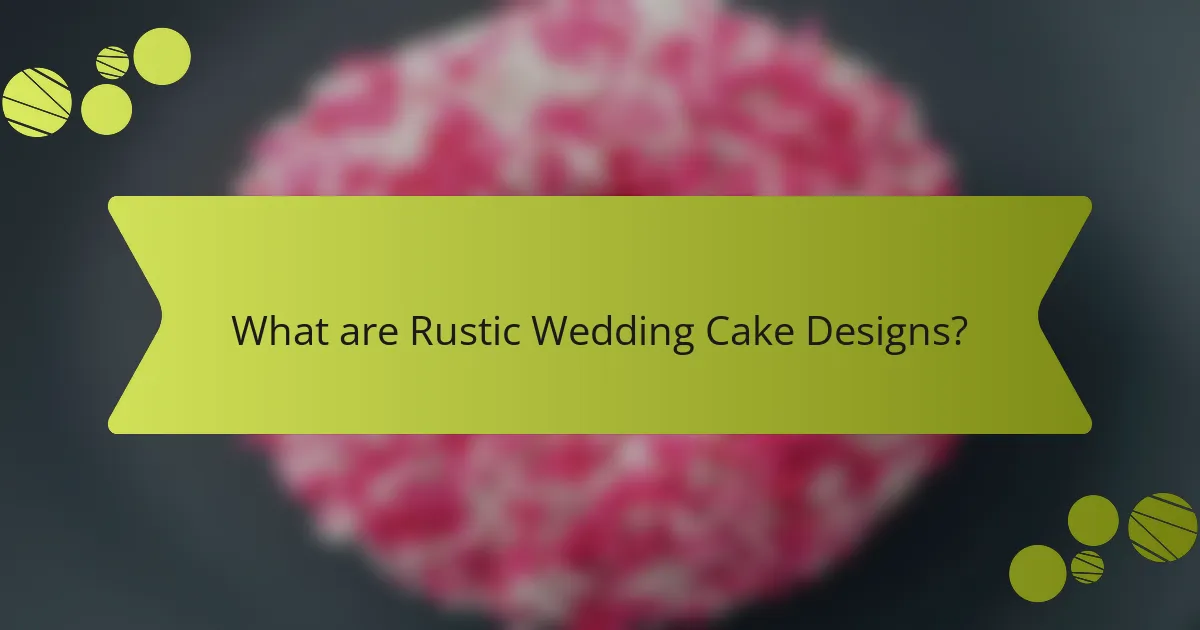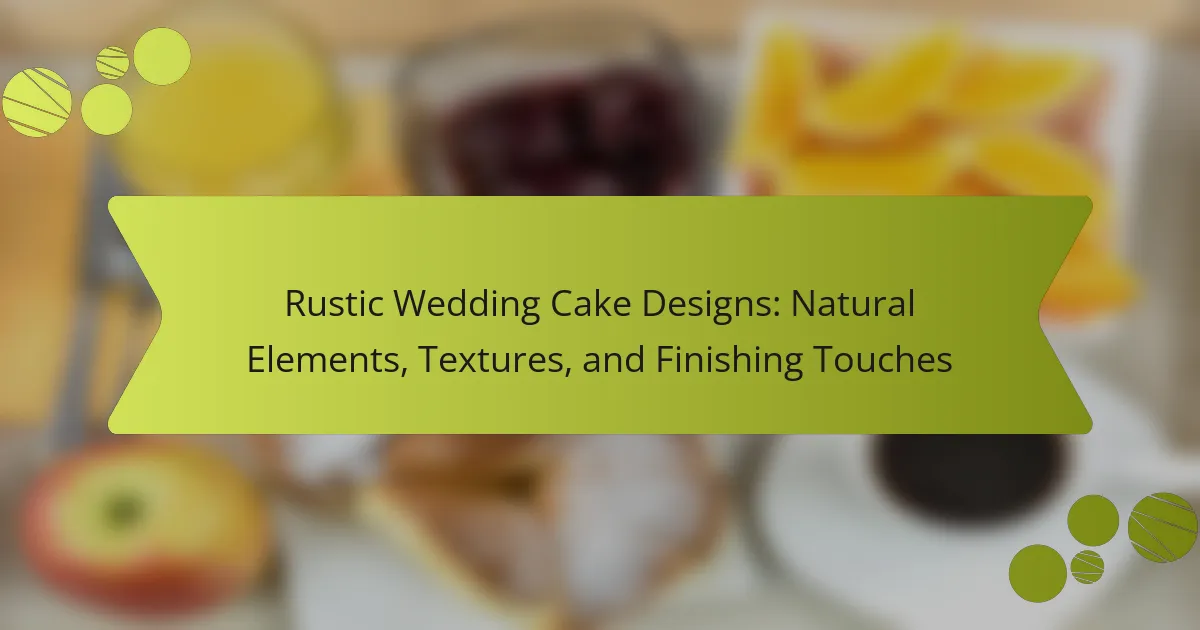Rustic wedding cake designs represent a natural and organic aesthetic, characterized by textured frosting, muted color palettes, and nature-inspired decorations. These cakes often incorporate floral accents, wood textures, and edible greenery, creating a warm and inviting atmosphere for wedding celebrations. Common design elements include multi-tiered structures with uneven edges, emphasizing simplicity and charm that aligns with countryside or vintage themes. The article will explore the various aspects of rustic wedding cakes, including their design features, color choices, and finishing touches that enhance their organic appeal.

What are Rustic Wedding Cake Designs?
Rustic wedding cake designs are cakes that embody a natural, organic aesthetic. They often feature elements like textured frosting, natural colors, and decorations inspired by nature. These cakes may include floral accents, wood textures, or edible greenery. Commonly, they utilize muted tones such as creams, browns, and soft pastels. The design emphasizes simplicity and charm, reflecting a countryside or vintage theme. Many rustic cakes are multi-tiered and may have uneven edges for a more handmade appearance. Overall, rustic wedding cakes aim to create a warm and inviting atmosphere for the celebration.
How do natural elements influence rustic wedding cake designs?
Natural elements significantly influence rustic wedding cake designs by incorporating organic textures and colors. These designs often feature elements like wood, flowers, and greenery. The use of natural ingredients, such as buttercream and fresh fruits, enhances the rustic aesthetic. Additionally, earthy color palettes reflect the surrounding environment. Textures like rough icing and uneven layers mimic natural forms. Seasonal elements are often included to align with the wedding date. The overall effect creates a warm, inviting atmosphere. This approach resonates with couples seeking a connection to nature.
What types of natural elements are commonly used in rustic wedding cakes?
Common natural elements used in rustic wedding cakes include flowers, greenery, and fruits. Edible flowers like lavender and roses add color and elegance. Fresh greenery such as eucalyptus or ferns enhances the organic feel. Seasonal fruits like berries or citrus provide vibrant accents. Nuts and herbs can also be incorporated for texture and flavor. These elements reflect a natural aesthetic that complements rustic themes. Many bakers choose these ingredients for their visual appeal and freshness.
How do these natural elements enhance the overall aesthetic?
Natural elements enhance the overall aesthetic of rustic wedding cake designs by adding organic beauty and texture. Incorporating elements like fresh flowers, greenery, and natural wood creates a harmonious connection to nature. These components evoke a sense of warmth and authenticity, which is essential for rustic themes. Textures from elements like bark or twine introduce visual interest and depth. Studies show that natural aesthetics can increase emotional responses, making the cake more memorable for guests. The use of earthy colors in these elements complements the cake’s design, reinforcing the rustic theme. Overall, natural elements contribute to a cohesive and inviting aesthetic that resonates with the rustic wedding atmosphere.
What textures are prevalent in rustic wedding cake designs?
Rustic wedding cake designs often feature textures such as rough icing, fondant draping, and natural elements. Rough icing provides an organic, unrefined look, mimicking the appearance of bark or stone. Fondant draping can create a soft, elegant texture that contrasts with other rustic elements. Additionally, textures like wood grain and floral appliqués enhance the rustic aesthetic. These textures are popular because they evoke a sense of nature and simplicity. Cakes often incorporate elements like edible flowers and twine, further emphasizing the rustic theme. Overall, the combination of these textures creates visually appealing and unique wedding cakes.
How do different textures contribute to the rustic look?
Different textures enhance the rustic look by adding depth and visual interest. Textures such as rough wood, burlap, and natural fibers evoke a sense of warmth and authenticity. They create a tactile experience that draws attention and invites interaction. For example, a cake adorned with textured fondant can mimic the look of tree bark. This resemblance reinforces the natural theme associated with rustic designs. Additionally, contrasting textures, like smooth icing against rough elements, create a dynamic visual appeal. Overall, the interplay of various textures is essential in achieving a cohesive rustic aesthetic.
What are some examples of texture combinations in these cakes?
Texture combinations in rustic wedding cakes can include smooth buttercream with rough bark-like fondant. Another example is fluffy sponge cake paired with crunchy nuts or caramel shards. Additionally, a combination of creamy ganache and textured fruit preserves can create a delightful contrast. Layering soft whipped cream with coarse sugar crystals enhances visual appeal. Textured floral decorations can also complement a smooth cake surface. These combinations enhance the rustic aesthetic while providing varied mouthfeel.
What finishing touches complete rustic wedding cake designs?
Finishing touches that complete rustic wedding cake designs include fresh flowers, berries, and textured frosting. Fresh flowers add a natural and organic look. Berries provide vibrant color and a touch of sweetness. Textured frosting, such as buttercream or cream cheese, enhances the rustic feel. Other elements like twine or burlap can be used for decoration. Edible gold or silver leaf can add a touch of elegance. Finally, wooden cake toppers can personalize the cake while maintaining the rustic theme. These finishing touches create a cohesive and visually appealing rustic wedding cake.
How do decorative elements affect the cake’s appeal?
Decorative elements significantly enhance a cake’s appeal. They create visual interest and convey themes or emotions. For instance, intricate designs can evoke elegance. Natural elements like flowers and leaves align with rustic themes. Textures add depth and dimension, making cakes more inviting. Color contrasts can attract attention and stimulate appetite. Studies show that visually appealing cakes are perceived as tastier. Overall, decorative elements are crucial for aesthetic and sensory engagement.
What are popular finishing techniques for rustic wedding cakes?
Popular finishing techniques for rustic wedding cakes include buttercream frosting, fondant draping, and natural decorations. Buttercream frosting is often used for its textured appearance. It can be applied in a rough, organic style to enhance the rustic look. Fondant draping provides a smooth finish while allowing for creative shapes. Natural decorations like fresh flowers, fruits, and herbs add authenticity. These elements create a charming, understated aesthetic. The combination of these techniques emphasizes the rustic theme and appeals to many couples.
How can you choose the right rustic wedding cake design for your event?
To choose the right rustic wedding cake design for your event, consider your overall wedding theme and color palette. Rustic cakes often feature natural elements like wood, flowers, or greenery. Assess the venue’s decor to ensure the cake complements the surroundings. Look for textures such as fondant, buttercream, or [censured] styles that enhance the rustic feel. Incorporate personal touches, like family recipes or favorite flavors, to make the cake unique. Research local bakers who specialize in rustic designs and review their portfolios. Schedule tastings to evaluate flavor and texture. Finally, confirm the cake size aligns with your guest count to ensure everyone is served.
What factors should you consider when selecting a rustic cake?
When selecting a rustic cake, consider flavor, design, and texture. Flavor should align with the preferences of the couple and guests. Popular options include vanilla, chocolate, or unique flavors like lemon or spice. Design should reflect the rustic theme, incorporating natural elements like flowers or fruits. Textures can enhance the rustic feel; options include [censured] cakes or those with rough frosting. The size of the cake must accommodate the guest list. Budget is also crucial, as rustic cakes can vary in cost. Lastly, dietary restrictions should be considered to ensure all guests can enjoy the cake.
How do personal preferences shape your cake design choices?
Personal preferences significantly influence cake design choices. These preferences encompass colors, flavors, and styles that resonate with individuals. For instance, a couple’s favorite color may dictate the primary hue of their cake. Additionally, personal tastes in flavors can lead to unique combinations, such as chocolate and raspberry. Cultural backgrounds also play a role, with traditions affecting design elements. A couple may choose floral decorations that reflect their heritage. Trends in cake design further shape choices, as couples often seek modern or vintage aesthetics. Ultimately, personal preferences create a cake that is a reflection of the couple’s identity and values.
What are some tips for creating your own rustic wedding cake?
To create your own rustic wedding cake, start with a simple, textured design. Use natural ingredients like buttercream or cream cheese frosting for a homemade feel. Incorporate elements like fresh flowers, fruits, or nuts for decoration. Choose a tiered structure for height and visual interest. Opt for neutral colors that evoke a natural look. Consider using a [censured] or semi-[censured] cake style to showcase layers. Ensure the cake is sturdy enough for stacking by using dowels for support. Lastly, practice your decorating techniques in advance to achieve the desired rustic charm.
How can you incorporate natural elements effectively?
Incorporating natural elements effectively involves using organic materials and textures in design. For rustic wedding cakes, this can include fresh flowers, greenery, and natural wood accents. Fresh flowers can add color and vibrancy, while greenery provides a lush backdrop. Using edible flowers enhances the cake’s aesthetic and ensures safety. Natural wood elements, like cake stands or decorations, add a rustic charm. Incorporating real fruits can provide a seasonal touch and enhance flavor. Textures like buttercream or ganache can mimic natural surfaces, adding depth. This approach aligns with the current trend towards sustainability in wedding designs.
What common mistakes should you avoid in rustic cake design?
Common mistakes in rustic cake design include over-decorating the cake. A cluttered design detracts from the natural aesthetic. Another mistake is using artificial elements that clash with rustic themes. Real flowers and natural textures enhance authenticity. Neglecting color harmony can also be an issue. Colors should complement each other to maintain a cohesive look. Additionally, poor structural support can lead to cake collapse. Proper internal support is essential for stability. Lastly, ignoring the cake’s flavor can diminish the overall experience. A beautiful cake must also taste good to leave a lasting impression.
Rustic wedding cake designs represent a natural and organic aesthetic, featuring textured frosting, muted colors, and decorations inspired by nature. Key elements include floral accents, wood textures, and seasonal ingredients that enhance the cake’s overall appeal. The article explores how natural elements and various textures contribute to the rustic look, along with popular finishing touches that complete the design. Additionally, it provides guidance on selecting and creating the perfect rustic wedding cake, considering personal preferences and common design mistakes to avoid.
